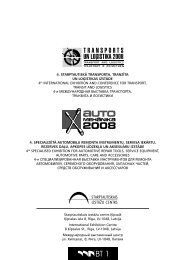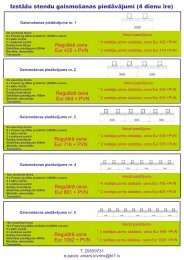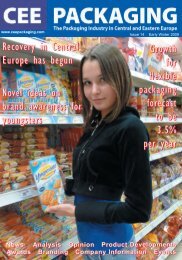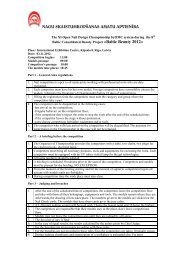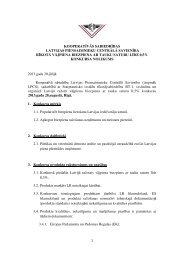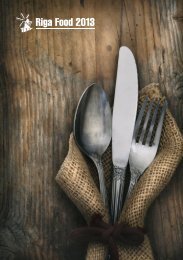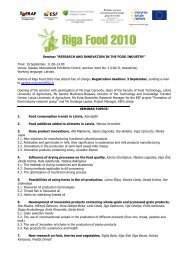BBeeeeeerrr ssaaallleeesss aaiiidddeeedd bbyyy ... - BT 1
BBeeeeeerrr ssaaallleeesss aaiiidddeeedd bbyyy ... - BT 1
BBeeeeeerrr ssaaallleeesss aaiiidddeeedd bbyyy ... - BT 1
Create successful ePaper yourself
Turn your PDF publications into a flip-book with our unique Google optimized e-Paper software.
Retail analysisHologram standard maycombat counterfeitsIssue 2850% of food wastedWhat future forbrand designcompanies?Beer sales aidedby packaginginnovationNews Analysis Opinion Product DevelopmentsAwards Branding Company Information Events
VISIT POLAND’SSHOWCASE FOR BRANDED& INSPIRATIONAL PACKAGINGVisit the future of packaging at PACKAGING INNOVATIONS,WarsawHala Expo XXI on 10 & 11 April 2013.Or visit one of our many other upcoming shows covering the full packagingvalue chain from design through to logistics. For details, visit www.easyfairs.comComing to a city near you!UPCOMING EASYFAIRS PACKAGING SHOWS 2013PACKAGING Birmingham, UK 27-28 February 2013EMPACK ‘s-Hertogenbosch, NL 27-28 March 2013PACKAGING INNOVATIONS Warsaw, Poland 10-11 April 2013PACK & EMBALLAGE Malmö, Sweden 17-18 April 2013VERPACKUNG Zürich, CH 17-18 April 2013VERPACKUNG-LOGISTIK Wels, Austria 12-13 June 2013PACK & EMBALLAGE Stockholm, Sweden 16-17 October 2013EMPACK Zwolle, NL 13-14 November 2013FREEREPORT Pick up your complimentary copyof the Innovations in Packagingpan-European survey 2012,produced in association withPackaging News(price to non-visitors: €195).www.easyfairs.com
CEE PackagingCentral and Eastern European PackagingTel.: +48 22 219 5466, +48 502 159080,www.ceepackaging.come. mail : alan@ceepackaging.comIssue 28What future for brand design companies ..........................................4Around the region ................................................................................7Strong growth for Ukrainian retailBeware of how you package beer at ChristmasRussian retail slowingRomanian retail market is growing albeit slowlySpecialist cosmetics chains increasing market share in Central EuropeHow smart are Polish shoppers?ContentsCorporate .............................................................................................15Coca Cola may not be as sustainable as the company wants us to believeMcDonald's to change packagingEnvironment ........................................................................................17Half of all food produced is wastedAluminium recycling hits fifty percentBiodegradable film keeping bread fresh for longerBioplastic demand could increase by five timesPoland now leading chicken producer in EUEU subsidies available for packaging Polish foodChanges in coffee consumption good for espresso businessThe growth of beer sales in Poland propelled by packaging innovationCzech confectionery producer instals new lineTechnology ...........................................................................................20New invention gives one-way PET kegs revolutionary featuresSolution devised to avoid wrinkling in shrink processIndustry winners .................................................................................22Semi hard cheese ripens in breathable filmEnvironmental award goes to Dulux for paint canGraham Packaging wins award for biopharma productsAnalysis ................................................................................................26New ISO standard will drive growth in 2013 says holography trade bodyCentral and Eastern European PackagingPublisher and Head Editor: Alan Heath, Deputy Editor : Marina BensonEditorial contributors : Diana Treskunova, Natasha Rezelova, Beata PrzybylskaAdvertising and subscription enquiries to :Alan Heath, +48 22 2195466 +48 502 159080 alan@ceepackaging.comSubscriptions to the daily newsletter only available electronicallyvia www.ceepackaging.comNo copyright claimed. Articles may be copied provided that the source is quoted.Join the CEE Packagingopen networking groups onFacebook and Linked In!CEE Packaging, www.ceepackaging.com Tel.: +48 22 2195466, +48 502 159080 3
CEE PackagingWhat future forbrand design companies?The last 50 years has seen a rise in the realisation of the power of brand design, comingfrom what was before, just a part of the advertising process. Today, brand design hasbecome one of the principal ways in which brands and products communicate with theircustomers.by Roland HemmingIt wasn't all that long agothat the only way to reach alarge number of potentialcustomers was through themedium of advertising onbillboards, in the press and ontelevision. Then, it madesense that advertising wasking and the brand was,…well just the companyname or the box a productcame in!But all that has changed.The wider distribution ofcable TV and niche programming,the coming of theinternet with its open accessto information and moreimportantly the enormousrise of retail, and with it,access to choice and purchasingpower. All these changesthat have happened in theintervening years, have allcome together to create ashift in power from manufacturersto consumers.Because of the growth of allthese influences, and becauseconsumers are now muchmore informed, or at leasthave more access to information,advertising has changed,and is now much more subtleand diversified than everbefore, blurring the distinctionbetween what used to be'above' or 'below the line'.Brand design, on the otherhand, has been like a shootingstar, seeing its importance tobrands and branding climb todizzy heights, recognised byall to be the bright and dazzlingway of the future.Brand design brings brandscloser to consumers, its brand4 CEE Packaging, www.ceepackaging.com Tel.: +48 22 2195466, +48 502 159080
CEE Packagingdesign that builds company or productnotoriety and has even been responsiblefor changing the way companies nowoperate. In our modern world, companiesare now evaluated by the power oftheir brand or brands, and are boughtand sold, not to expand production facilities,but to complete or expand theirbrand portfolios and market presence. Infact, more and more, we see that brandcompanies don't actually manufacture atall and that in some cases the product isactually irrelevant!Behind this expansion of the power ofthe brand and with it, brand design,there grew an entire new creative industry,some might say 'cottage industry',because in the beginning, most of thedesign companies were set up, by talentedindividuals who created 'small teams'of highly creative people. However lookingback, we can see now that these'small teams' had an influence that faroutweighed their size, for there is nodoubt that these 'small teams' became ina large part responsible for the growth ofbrands and the expansion of many of theworld's largest companies that we seetoday.In time, the influence of the branddesign companies expanded even further,and the strategic thinking and branddevelopment tasks, previously in thehands of the advertising agency, shiftedto the design companies, and with thisshift, the design companies began toinclude marketing, research and strategicthinking departments into their offer,thereby capturing an even larger part ofwhat used to be the advertisers territory.But, just like any shooting star, thebrand design company's meteoric risewasn't going to last!Advertising agencies were, and remain,rich and powerful, with their large functioningoffices throughout the world,whilst their clients, 'the brand companies',became truly international withglobal aims, global strategies and globalneeds. Whereas, apart from a few exceptions,the now aging founders of the 'cottageindustry' that was brand designfound themselves in the wrong place atthe wrong time, thinking and actinglocal when the world of brands hadbecome global!In this brave new world, the needs ofthe brand companies had changed andthe advertising agencies were there withthe infrastructure that the brands needed,and if they didn't have the branddesign expertise any more in-house?…...well, no problem, they had themoney to buy up the best design companiesand with them, all the expertise theyneeded. This is just what they did!So, does this mean the end for designcompanies as we know them?I suppose the answer is yes and no!Clearly, there is no going back to the waythings were in the dizzy heights of thepast. What we are seeing today is apolarisation of the design industry, with,Brückner Group atINTERPLASTICA29 Jan - 01 Feb 2013,MoscowForum, Booth FB46HIGH QUALITYFILM PRODUCTION CEE Packaging, www.ceepackaging.com Tel.: +48 22 2195466, +48 502 1590805
CEE Packagingon the one hand, the bigger, 'advertisingagency owned', design companiesexpanding to deliver the needs of theirglobal clients, and on the other hand, thesmaller, highly creative, design studiosacting like 'squat teams', successfullyintervening when necessary to bring thesharp creative thinking that is so hard toget from larger organisations.Where the outlook is bleaker, is for themedium sized design companies sittingin the middle, where, just like for thebrands themselves, the market is shrinking,or rather migrating to the edges.The good news is, that the future ofbrand design itself continues to be ashealthy as ever, of that there is no doubt,but the industry is inevitably undergoinga radical change. It seems that we arereturning, once again, to the age of theadvertising agency, although because ofthe brief and brilliant rise of the designcompanies, the shape and the role ofadvertising has been forever transformed.Now, the advertising agenciesfind themselves to be the owners of someof the biggest and best design companiesof the world, companies they can feedwith projects from their advertisingclients, and can expand throughout theworld to support the global aims andlocal proximity that their client's marketingstrategies demand. But also, these'agency owned', brand design companieswill inevitably change their thinking andchange their organisations from within.However, I still believe there is animportant role for the smaller designcompany, because as we are all aware,'innovation rarely comes from the centre',large corporate companies are justthat, 'large' slow moving and often managedfrom high up, far away from the'factory floor'. This is where the smaller'design squat teams', can have the advantage,by being highly creative, fast moving,knowledgeable and effective, workingclose to the market, close to consumersby creating young, dynamicteams of creative people who are intouchwith what's going on.Challenging the status-quo and daringto be different is the natural territory ofthese teams, being 'ahead of the curve'even 'creating the curve', when necessary- for these creative individuals, there hasnever been a 'box' to think outside of, it'sthe larger organisations that create the'box' around themselves.This is why this year my colleagues,and I created the first mobile 'designsquat team' to bring strategic thinkingand high creativity where and when it'sneeded.We call our new team LeKub-PKG.We have no office, because we live'outside of the box' close to the brandsand the markets we work on. We are indifferent countries, but you will also findus available to jump in when necessary tobring smart thinking and creativity tosolve packaging and branding needs.Leveraging our high level of expertisebased on our extensive joint experienceof executing brand and packaging designprograms throughout Europe and bringinga new perspective to brands.6CEE Packaging, www.ceepackaging.com Tel.: +48 22 2195466, +48 502 159080
Around the regionStrong growth forUkrainian retailIn 2011 the Ukrainian retail market, which increased byalmost 27 percent year on year, was worth UAH571bn(EUR60bn). The retail market continues to grow butgrowth last year was certainly much lower and this declineis likely to continue. Nonetheless, the retail market isgrowing and that is a good sign!According to the PMR report, Retailin Ukraine 2013. Market analysisand development forecasts for 2013-2014, the Ukrainian retail trade marketgrew in value to UAH571bn (USD72bn)in 2011, a year-on-year increase ofapproximately 27 percent. In comparisonwith the preceding year, the market continuedto rebound in 2011, and may possiblyeven have accelerated in terms ofgrowth. It was strongly supported by therecovery of the Ukrainian economy, animprovement in consumer sentiment, areduction in inflation, a 6.1 percentincrease in real disposable income and anincrease in the popularity of modernretail store formats. According to PMRestimates, the retail market will maintainits rate of growth of around 20 percentper annum to UAH 973bn (USD122bn)in 2014. Real disposable income and lowinflation will remain among the keydrivers of growth.Fozzy Group keeps its leading positionThe Fozzy Group XE "Fozzy Group"remains the largest retail market playerin Ukraine in terms of revenue. It is adiversified retailer, with a presence ingroceries, consumer electronics andpharmacy retail. In 2011, it had a 3.4percent retail market share. ATB-marketis the second most prominent company,with a 2.6 percent market share the sameyear. Over the last few years, the companyhas significantly increased its marketpresence, supported by a substantialincrease in demand among Ukrainiansfor discounter store formats. It is currentlythe largest retail sales chain inUkraine in terms of store count.EpiCentr K, the DIY retailer, was thethird most prominent company in 2011,accounting for about 2.1 percent of theretail market.Of the 10 largest retailers in Ukraine,only three are non-food concerns: twoare consumer electronics companies(Foxtrot and Comfy), and one is a DIYchain (Epicentr K).Overall, the top 10 players accountedfor more than 14 percent of the marketand had more than 1,800 stores in 2011.According to PMR estimates, their marketshare could have risen to almost 16percent in 2012, and the number ofstores could exceed 2,000. Among theleading 10 companies only two are foreignand these, the Metro Group and theAuchan Group, are grocery concerns.Beware of howyou package beerat ChristmasBefore Christmas, the Ukrainian easternorthodox church took a dislike tocertain beer packaging it observed inKiev.It would seem that certain beer producerswere suggesting that Ukrainiansknock back a few beers in the time ofpeace and good will to all people.The church thinks that this is unethicalto use Christmas as an excuse forselling things and that this is using theauthority of religious institutions tocommercialise alcohol. Christmas beerwas sold by two large Ukrainian breweries.One of them used a label showingchurch towers and the characteristiccross of the eastern church.The church issued a statement whichincludes the clarification that one couldunderstand if wine were labeled withreligious symbols as it is used in theEucharist sacrament but it is unacceptablein the sale of beer and vodka.Ukrainian MP Hanna Herman saysthat she will propose a law banning theuse of religious symbols on alcohol.This may pose a problem for thosewondering if their beer, vodka or wineis kosher or not. In the meantime MsHerman is calling for a boycott of thoseproducts showing religious symbols ontheir packaging. This ought to showhow much support there is for a changein the law, and now that Christmas isbehind us, hopefully the culprits will letus know what happened.Russian retail slowingThe retail market in Russia will continueto see further growth, however, thegrowth rates are expected to be lowerthan in the last two years. The main factoris the increasing maturity of the marketwhere customers are making moreinformed and careful buying decisions -and are less likely to be swayed by promotionsor unusual packaging. The slowdown in the economy is a second, but lessimportant, factor.CEE Packaging, www.ceepackaging.com Tel.: +48 22 2195466, +48 502 1590807
Around the regionRomanian retail marketis growing albeit slowly!The grocery retail market in Romania, covering both fresh and packaged food and nonfoodproducts sold in grocery stores, was worth RON 58.1bn (EUR13.7bn) in 2011. Themarket is expected to show less than one percent growth for last year.The global economic crisis negativelyimpacted the market not only in2009 but also in 2010. The slightlyimproved economic situation led grocerysales in Romania to increase by 3.2 percentto RON58.1bn (EUR13.7bn) in2011. However, the value of the marketwas lower than the peak value in 2008.Although in the past the market experienceddouble-digit growth, such figureswill not return at least until 2015.In 2011, Romanian retailers were ingeneral divided into two groups. Thefirst, consisting of major internationalplayers, used their capital for expansion,especially as land prices fell and alsosome chains were easy to take over. Thesecond group was comprised of manysmaller Romanian companies thatunderwent major financial difficulties,leading some of them to go bankrupt,declare insolvency, close down somestores, or at least change their expansionplans. Yet, even among local players,there were those that managed toincrease their number of stores such asUnicarm, Agricola Bacau, Annabella,Succes, LeFruMarin and Alba Market.Last year the market almost certainlyshowed no more than one percentgrowth.Modern retail in Romania grew withthe entry of large format stores in thecountry. In 2011, the trend was strengthenedby hypermarkets and discounters.Both formats opened outlets and coveredmore towns, and also attracted customerswith many promotional campaigns andreduced prices.The traditional formats of retailaccounted for approximately 43.6 percentof the Romanian grocery market in2011.The share fell compared to the yearbefore due to further expansion of themodern grocery chains. A few years agotraditional retailers started to lose thecompetition, especially to hypermarketsand discounters, as they were not able tooffer competitive prices and a broaderrange of products. Moreover, as supermarketchains owned by producers startedto expand rapidly a year ago, thedownward trend of traditional retail willbe sustained.In the next three years, all modern formatswill try to return to their doubledigitgrowth. Even in the last three years,when the grocery market underwentmajor difficulties, modern retailers managedto gain a bigger market share. Allthe major players are planning to expandin the next few years.Nowadays, major retailers cover mostof the country's largest cities and aremoving towards smaller towns. Low levelsof urbanisation, however, make it difficultfor large-format retail to reachrequired profitability levels, somethingthat is simpler to achieve for smallerstores.Thus, all modern formats have thepotential of further expansion.8 CEE Packaging, www.ceepackaging.com Tel.: +48 22 2195466, +48 502 159080
Around the regionSpecialist cosmetics chains increasing marketshare in Central EuropeExpanding specialised cosmetics chains have been increasing their market share amongcosmetics distribution channels in Central Europe. On the other hand, direct sellers havebeen losing their importance due to growing competition not only from retail chains butalso from quickly growing internet sales.Specialised cosmetics chains have beenincreasing their share throughoutCentral Europe. In the Czech Republicand Poland, they already account for thelargest shares of cosmetics sales.In the Czech Republic, specialisedchains now have over 40 percent of themarket. In Poland, chains are rapidlygrowing in importance at the expense ofindependent stores. Chains control 34percent of the market, up from 21 percentin 2007. Rossmann in particular isgrowing fast. Chains are also increasingtheir sales per store. They appeal to consumersby offering attractive prices, frequentspecial offers, a wide mediumpricerange and staff assistance.Chains are also the most importantchannel in Hungary and Slovakia, whilein Bulgaria they are gaining ground withthe expansion of the dm and Lillychains.On the other hand, the specialisedchains are slow in reaping the benefits oftheir investment in Romania, mainlyspending on cosmetics and the increasingcompetition of the internet, directbecause of the slow change in consumerattitudes. Most middle-class Romaniansselling companies have been investing inhave turned their attention to large-areatheir online platforms, including Avongrocery stores and specialised chains areand Oriflame.seen as a more high-end channel.Weakening importance of direct salesDirect sellers such as Avon and Oriflamehave been hit by these trends.In the Czech Republic and Poland,direct sellers remain among the largestplayers on the cosmetics market. Whilestill popular, in Poland the channelimproved its sales only slightly in 2011.Players are therefore constantly on thelookout for new ways of keeping theirshare in the market. Some direct salescompanies are expanding to smallerlocations where competition is less.Direct sales have been falling inRomania for the past four years althoughthey still have a 19 percent share - whichis the highest share in any CEE country.In Bulgaria, Avon has been a marketleader in cosmetics distribution but islosing share when new strong companiesexpand. Dm's rapid development especiallychallenges its market position.With the economic crisis biting intoMarket worth around EUR8.6bnIn 2012 the overall value of the CEEcosmetics market probably grew byaround 1.5 percent. Bulgaria andSlovakia possibly saw higher growthrates compared to 2011. Romania andPoland will be growing the fastest with arate of 2.2 percent. In case of Romaniathis is, however, much lower than previouslypredicted.The market almost certainly fell in theCzech Republic and Hungary. InHungary, macroeconomic indicatorsdeteriorated in 2012. In the CzechRepublic both economy and private consumptionare declining and growth ofwages does not offset rising prices.CEE Packaging, www.ceepackaging.com Tel.: +48 22 2195466, +48 502 1590809
Around the regionHow smart arePolish shoppers?Are Polish consumers rational? Are they smart shoppers? How has, or how is the globalcrisis affecting consumer behaviour? Is the deteriorating economy influencing shoppinghabits in the area of everyday products? How do they react to packaging innovation andhow does packaging affect their choices? Analysts PMR searched for the answers tothese and other questions about the shopping habits of Polish consumers.Recent years saw a rise in popularityof the term ‘smart shopping’, understoodas a tendency to invest time intosearching for information about offers,comparing prices of products, and savingmoney. This versatile worldwide trendhas its foundations in the effects of theglobal crisis 2008-2009, and the continuingmood of anxiety about the future.For many years the shopping model inPoland was at odds with the western one,it was a call back to the era of communismand deficit economy. Being smartwas based on different models of obtaininggoods, including basic need products.After 1989 Polish consumers threwthemselves into the free market and areal shopping frenzy. It was the start ofostentatious consumption, where thebrand and - paradoxically - high pricewere an element of creating a better consumerimage. In order to elevate theirstatus, buyers were ready to take outloans in order to fund further purchases.10 CEE Packaging, www.ceepackaging.com Tel.: +48 22 2195466, +48 502 159080
Around the regionThe expansion of hypermarket chains,easy access to goods, and high diversificationof prices in almost any categoryresulted in the availability of an FMCGproduct range comparable to Westerncountries. With time the trend of shoppingsprees has definitely reversed.Thesedays a higher shopper status is achievedby smart shopping, in other words bybeing clever, skilfully searching out realoffers and bargains and not overpaying.According to analysts PMR, one ofthe reasons why Poland has suffered relativelymild effects of the crisis is theshopping optimism of Polish consumers.This optimism has enabled the internaldemand to remain at a sufficiently highlevel. However, high consumer spendingdoes not mean extravagance. The smartshopping model has been introducedfrom the west. Although the Polisheconomy has been in quite good shapecompared to other countries, Polish consumerswant to be smart too.Poles have the highest ‘Shopping IQ’According to research, Poland shows alot of potential. In a European studyconducted for Visa UK by research andgrowth forecast centre The FutureFoundation, Polish consumers achievedthe best general result in ‘shopping IQ’tests, and have been classified at the forefrontof the European ranking ahead ofthe French, Czech and German consumers.The study has shown that Polesdo very well when comparing or tryingnew products, as well as exercising selfcontrolduring daily shopping.A study carried out by PMR Researchhas demonstrated that Polish consumerswant to be smart in their everyday shopping,and know many ways to shop‘intelligently’ for groceries and dailyproducts. Optimising shopping decisionsdoes not stop at the level of home budgetsor sales channels, but goes muchdeeper - to the level of product categories.Buying private label products is a partof the smart shopping strategy. Thechoice of a cheaper product must, however,be based on trust. We can observetwo levels of trust towards private labels:trust in the manufacturer (the example ofBiedronka) and in the chain (Lidl).Importantly, the choice may be postrationalisedfrom the point of view of thebuyer, which translates into a significantlyhigher chance of another purchase forthe seller. In other words, positive verificationof trust towards own brands leadsto buying the products again.Packaging most importantOther than price, packaging seems to bethe most important at the first purchasestage. Satisfaction with the product is thecondition to buy it again. The packagingof private labels should be attractive, butsimple enough to avoid the impression ofpaying for packaging. It is also importantthat it does not bring association with acheap imitation of a top brand.The PMR study of female consumersresponsible for daily shopping revealedseveral crucial shopping tendencies.Not all the products in the shoppingbasket meet the same quality standardsor requirements, with cheaper productshidden in between. Consumers try tobalance price segments and product categories,playing with different productswhen planning family meals - poorerquality pasta, but with a better sauce ormeat. Consumers make shopping lists,check what they need before going shopping,stock up on basic products, buywith specific meals in mind, putting onlynecessary products in their basket. Smartconsumers want to shop quickly andconveniently - in a location near home orwork, and in a well-arranged store space(convenient shelf arrangement, intuitiveproduct layout), which allows them tosave time spent on shopping. Time isalso important in the context of offersand price cuts - a smart shopper is not abargain hunter. Consumers calculate thetime and cost of reaching a store in orderto decide whether an offer is really valuableand profitable.CEE Packaging, www.ceepackaging.com Tel.: +48 22 2195466, +48 502 15908011
Around the regionPoland now leading chickenproducer in EUIn 2012 Poland became the leading producerof chicken in the EU. This growthis largely thanks to the growing exportmarket.In 2011 Poland passed from thirdplace to second and this year it has overtakenthe UK - formerly the leading producerin the EU. Around 1.5m tonnes ofchicken were produced in 2011 and sofar this year this has increased by about18 percent.In the past eight years the amount ofchicken produced by Poland for exporthas doubled. In the first eight months ofthis year alone, chicken production hasincreased by 26 percent to 297,000tonnes. Nonetheless, the home market isgrowing too. At a time when sales ofpork and beef are falling, chicken is ingreater demand. The average Pole nowconsumes around 26kg of white meat peryear - almost entirely chicken. This is anincrease of 400 grams when compared to2011.As a whole, the EU is likely to show anexport growth of around nine percentmore white meat for 2012 when comparedto 2011. Whereas chicken makesup the bulk of this, more specialty meatis also showing growth. Duck has seen37 percent growth and goose fifteen.EU subsidies available for packaging Polish foodThe Opole branch of the Polish agriculturalagency has encouraged producers tomake the most of EU money for promotingwhat it terms as high qualityproducts.These funds also could be used forpromotion in packaging too. At stake isaround EUR10m in grants.Packaging of course is not likely tomake a large amount of this as thoseconcerned are more likely to considerusing traditional means of promotionsuch as television advertising or perhapsstands at trade fairs. Nonetheless theagency did mention what it terms as'ecological packaging' as a form of promotion.Subsidies could be as much as seventypercent according to the agency. OnlySurprisingly most of this growth hasbeen to Africa, traditional markets suchas South East Asia, Saudi Arabia andRussia have actually been taking lesswhite meat. Exports to Russia fell byaround 4.5 percent in the first half of lastyear which may have been one reasonwhy prices escalated at the end of thesummer in that country.food producers can claim - although ofcourse they could work out their strategywith packaging producers.Funds have to be completely used by30 June 2015.Changes in coffeeconsumption goodfor espresso businessCoffee use in going through a majorchange in many countries and especiallyin central and eastern Europe.One of the companies that is benefitingfrom this is Nespresso which hasseen growth in two figures in variouscountries perhaps more due to theconcept and its packaging rather thanthe taste.To take Poland as an example,Euromonitor International estimatesthat retail sales come to 108,800 tonscompared to 109,200 tones in 2011.Euromonitor believes that this couldfall to 106,300 tons. This does notmean that people are drinking lesscoffee, they are certainly drinkingmore outside of their homes and theyare certainly drinking more in singleportion containers such as Nespressooffers. What they may be doing isdrinking less packaged ground coffeewhich weighs more.Euromonitor forecaststhat Poles will spendPLN115m on expressoalone and that thiswill increase to PLN136m by 2015.Nespresso will no doubt continue tomake good sales, thanks in part to theinternet and also to new sales pointswhich the company says that it willopen.This is coming at a time whengrowth of coffee shops in Poland maycome to an end as the VAT on coffeepurchased in such outlets increasedfrom eight percent to 23 percent at thebeginning of the year.Although none of the major chainshave yet said what this will do toprices, it is unlikely that they will beable to take on a 15 percent increase intaxation. Most, if not all, the cost willhave to be borne by the customer. Thegrowth of coffee houses has led toincreased competition and as a resultcost cutting especially in shoppingcentres. This in turn could boost salesof single serve coffee solutions such asthat offered by Nespresso.12 CEE Packaging, www.ceepackaging.com Tel.: +48 22 2195466, +48 502 159080
Around the regionThe growth of beer sales in Polandpropelled by packaging innovationThis publication began forecasting for some time that this will be a record year forbeer sales in Poland. Of course this is nothing other than a statement of the obvious.There was an excellent summer in Poland which started early with the temperaturewell into the thirties by the third week of April. Coupled to this there was the footballcompetition Euro 2012 held in Poland and the Ukraine. Furthermore the OlympicGames may also have had some positive effect on beer sales.As of at the moment of writing we donot know what the final tally forbeer sales was last year. The head of theZywiec brewery, Xavier Belison, believesthat it will show an increase of four tofive percent in the sales of beer inPoland although in 2013 a contractionof one to two percent is to be expected,although of course the market isdependent on many factors which cannotbe planned. The Zywiec bossnonetheless believes that his companywill maintain its market share.The head of Zywiec believes that thebeer market will increase not only due tothe introduction of new beers but also toinnovations in packaging. In variouscountries this has meant packagingabove all in cans, although this trend hasbeen less obvious in Poland.At the same time Xavier Belisonbelieves that the hard discounters willsell increasingly more beer, perhaps evenreaching thirty percent of all beer salesin Poland. In August 2012, they soldaround twenty percent of all beer sold inPoland. This compares to ten percent in2009. Given the increased market shareof the retailers, it is logical that packagingwill have a strong effect on the saleof beer in Poland and this will be somethingto think about not only duringsporting events.Regional successRegional breweries in Poland may havetaken around a ten percent share of thebeer market last year. This is good newsnot only for them but for those thatdesign and manufacture their packaging- which needs to make it stand out fromthat of the multinationals to emphasizeits difference.Given the growth in demand for suchspecialities and an increasing awarenessof local identity, the trend in Poland isvery much likely to follow that in othercountries.Year to rememberThe excellent long summer togetherwith the sports events was a dream cometrue for beer producers! Unfortuntatelyit is unlikely that either Poland or theUkraine will host another major sportingcompetition for many years.Without doubt, Russian breweries willbe hoping for a similar result in 2018when that country will host the footballWorld Cup!CEE Packaging, www.ceepackaging.com Tel.: +48 22 2195466, +48 502 15908013
Around the regionCzech confectionery producerinstals new lineConfectiionery manufacturer POEX, a.s. is based near Brno. The company packs coatedand uncoated fruit and nut products, extruded and co-extruded cereals and snacks,extruded crisp breads and promotional items for its own range and as private label forvarious retailers.while again providing the speed neededto keep up with POEX's increasedcapacity.POEX has achieved its aim of increasingcapacity, with a typical output performanceof five tons of confectioneryper shift. But, as Jaroslav Caha puts it‘What has been most beneficial for ourbusiness has been the accuracy across arange of products, with practically zerogiveaway, and the improvement in finalinspection.’The company decided to increase itscapacity for chocolate-coated andother nuts, as well as dried fruit, with acomplete new Ishida line to include X-ray inspection system and checkweigher.POEX had in the past used both linearweighers and volumetric fillers and,most recently, locally manufactured multiheadweighers.'We pack at target weights rangingfrom 30g to 500g, with the average beingin the region of 100g,' says JaroslavCaha, Head of Poex's packaging division.'This is mostly into pillow bags,but also into stand-up bags.The previousline produced forty packs per minutecompared with the 75 packs per minutewe are now achieving with the new line.That's a near-90% improvement.‘In the past, the problem was that thefaster we ran the machines, the less accuratethey became. It was quite difficult toget the level of feeder vibration right inorder to keep the product flowing.’With the new multihead weigher, theaccuracy, even at the higher speeds, hasbeen such that giveaway is down to nearzero. For a 100 g target weight, the meanweight is about 100.1 g and standarddeviation is only about 0.2 g.As well as improvements in productionefficiency, POEX also wanted thenew line to pay equal attention to productquality and safety. The Ishida IX-XrayInspection System it installed is ableto detect even tiny particles of materialsthat could conceivably contaminate confectionery,including metal, glass, stone,rubber and plastic. Equally important,the high belt speeds (up to 60metres/minute) help maintain the excellentthroughput achieved by theupstream equipment.Stationed immediately after the X-raysystem, and sharing a double reject bin, isan Ishida checkweigher. It brings animportant level of reliability to ensuringcompliance with weight regulations,14 CEE Packaging, www.ceepackaging.com Tel.: +48 22 2195466, +48 502 159080
CorporateCoca Cola may not be as sustainable as thecompany wants us to believeCoca-Cola has issued a sustainability report in which it claims that since the beginningof the century it has reduced the amount of calories per serving by nine percent annuallywhilst backing sports events (such as the recent Euro 2012 held in Poland and theUkraine), made significant charity donations, aims to be water neutral by 2020, backed acampaign to support polar bear conservation and distributed more than 10 billion what itclaims are fully recyclable PlantBottle packages in 24 countries. Critically howeverthings are not so rosy as the company would have us believe.Coca cola has been able to reducecalories but this has been achievedby the introduction of various no caloriesparkling beverages, waters, juice andjuice drinks, sports and energy drinks,teas, coffees, and milk and soy-basedbeverages which is flavoured with saccharinewhich may be more negative forthe health than sugar.The support for polar bears and forbacking the Arctic environment is highlylaudable, however backed with suitablepackaging and advertisements, it wasclearly a marketing ploy and Coca Cola'sresults would bear out (pun intended)how effective this was.2012, it announced a partnership withJBF Industries Ltd. JBF Industries Ltd.will build the world's largest facility toproduce bioglycol - the key ingredientused to make PlantBottle packaging.The company is now one of manybeing targetted by the Russian healthministry which seeks to put a tax onwhat it terms as being unhealthy highcalorie foods such as carbonated drinks,crisps and certain types of fast food.This may damage the image it is tryingto create through sports sponsorship butat the same time it is unlikely that itwould lose many clients because of theprice hike as all its competitors wouldface the same problem.The use of the PlantBottle is alsoclearly a marketing ploy. The package isnot 100 percent recyclable as the companyclaims and any reuse of materialsneeds to be backed with suitable collectionand processing and the company isunable to provide information aboutwhere this is coming from. Nonetheless,Coca Cola says that it would have had touse the equivalent of more than 200,000barrels of oil without the bottle in thepast three years. To continue to accelerateglobal production of plastic packagingmade from plants, in SeptemberA spokesperson for Coca Colaclaimed in a press release 'We recognizethat the sustainability of our businessdepends on the health of the communitieswe serve. We also know that wewon't reach our 2020 Vision of doublingthe business without embedding sustainabilityinto our business to drive efficiencyand effectiveness.' That much, probablymost people would agree with.Get the facts behind the corporate hype and greenwashing by registering for the CEE Packaging daily newsletter :www.ceepackaging.comCEE Packaging, www.ceepackaging.com Tel.: +48 22 2195466, +48 502 159080 15
CorporateMcDonald’s tochange packagingOne of the world’s largest consumers of single serve packaging materials is to change the waythey look. McDonald’s claim that this will give the customers more information and improvetheir environmental footprint. Not so, say environmentalists who point to poor performance sofar in providing information for customers and on use of renewable resources.McDonald's has unveiled new packagingdesigns on all carry-out bagsand fountain beverage cups with quickresponse (QR) codes, used with smart‘phones, which it claims will provideconsumers with information to helpthem make informed choices, and ifnothing else will give them something toread whilst eating their hamburger.want to know more about the food theyare eating and we want to make that aseasy as possible by putting this informationright at their fingertips.'The launch began in January 2013 inthe U.S. and will continue rolling outworldwide throughout 2013, with thetext being translated into 18 languages.McDonald's claimed in a press releasethat the QR codes 'will deliver interestingfacts about the brand and makenutrition information easily accessiblefrom mobile devices'.'Our new packaging is designed toengage with customers in relevant waysand celebrate our brand,' Kevin Newell,McDonald's Chief Brand Officer wasquoted in the press release as possiblyhaving said. 'Customers tell us theyMcDonald's claims that it consulted agroup of independent advisors in theareas of nutrition, public health and fitnesswho emphasized the importance ofproviding access to nutrition information,and support using the new packagingto directly connect customers toinformation about McDonald's menu.McDonald's further claims that thisinformation is already available throughin-restaurant menu boards although nooneconsulted by this writer had noticedthem in various countries. Possibly ourstaff were too busy gorging themselvesto notice! In the US, Taco Bell openlydisplays the amount of calories in itsproducts on the menu boards.Secret in the branding and packagingThe secret of McDonald’s has been in itspackaging and brand image, not by itsfood which although tastes nice, is madeup of cheap ingredients using a lot of saltand sugar. A typical meal will composeof a large percentage of a person's dailycalorie intake and possibly all or evenexceed the amount of sugar and salt thatone should consume in a day accordingto healthy eating website calorie counter.It is of course a major consumer of packagingproducts, nearly all of which findtheir way to landfill or incinerationalthough separation of food and packagingwaste could be easily achieved.Packaging greenwashMcDonald's claims that nearly 80 percentof its consumer packaging is madefrom renewable paper or wood-fibrematerials ‘in some markets’. This claimwas described as ludicrous by one environmentalgroup and attempts to discoverhow much of its packaging genuinelydoes meet this standard inEurope were not responded to either bythe McDonald’s corporate office inWarsaw nor their head office in the US.Whatever the case may be, the companyhas not even made any pretence aboutits new packaging being any ‘greener’than what it was using before.16 CEE Packaging, www.ceepackaging.com Tel.: +48 22 2195466, +48 502 159080
EnvironmentAluminium recyclinghits fifty percentRecycling rates for alufoil trays and semi-rigid containers across Europe rose above 50percent in 2010 (2008: 45 percent) helped by the industry's commitment to promote thebenefits of resource efficient and sustainable packaging options.Aluminium is endlessly recyclable,which the industry body claimssaves up to 95 percent of energy usecompared with its primary production.This message is increasingly recognisedby the packaging supply chain, or soclaims EAFA, while consumers areshowing greater willingness to play theirpart across Europe.Khosrow Tahmasebi, EAFA'sContainer Group chairperson, claimed:‘The alufoil industry actively promotesand shares best practice to support itscustomers to reduce the environmentalfootprint of its products. Our primary making Europe more sustainable.’objective continues to be to increase The additional financial support fromrecycling rates further and in so doing EAFA container manufacturers to supportnational recycling initiativesthrough organisations such as Alupro(UK) or FAR (France AluminiumRecyclage) is now showing the first positiveresults in the latest recycling figures.Recycling rates continue to vary considerablyby country. But acceptance ofthe benefits of aluminium recycling isbeing underpinned by the investmentfrom local authorities and waste managementoperators throughout Europe.Even in these difficult economic timesthey are commissioning the latest sortingand recycling technologies.‘In parallel with this latest increase inthe average percentage of alufoil containersbeing recycled in Europe, the aluminiumand semi-rigid container industrycontinues to invest in new technologiesto further light-weight these containersthereby making them even moreresource efficient,’Tahmasebi.added KhosrowSeeking packaging suppliers?Advertise your needs free of charge on our daily newsletter!Write to alan@ceepackaging.com18 CEE Packaging, www.ceepackaging.com Tel.: +48 22 2195466, +48 502 159080
EnvironmentBiodegradable film keepingbread fresh for longerVerDeSoft GmbH is a Nurembergbasedpackaging design company, whichdevelops innovative packaging solutionssuch as ideas for keeping bread fresh forlonger.The 'breadbox' prototype pack is madeof board and shaped like a real breadboxwith a roll down top and transparentwindow. It is sized to hold an individual(quarter) portion of a loaf of bread.Thomas Reissig, founder ofVerDeSoft GmbH explained: 'Endusersare increasingly looking for packagingwhich not only looks good, butoffers green credentials in addition toprotecting the product inside. This packticks all of these boxes and more.'The NatureFlex NK film used inBioplastic demand could increaseby five timesThe worldwide production capacity forbioplastics will increase from around 1.2million tonnes in 2011 to approximately5.8 million tonnes by 2016. By far thestrongest growth will be in the biobased,non-biodegradable bioplastics group.Especially the so-called 'drop-in' solutions,i.e. biobased versions of bulk plasticslike PE and PET, that merely differfrom their conventional counterparts interms of their renewable raw materialbase, are building up large capacities.Leading the field is partially biobasedPET, which is already accounting forapproximately 40 percent of the globalbioplastics production capacity. Partiallybiobased PET will continue to extendthis lead to more than 4.6 million tonnesby 2016. That would correspond to 80percent of the total bioplastics productioncapacity. Following PET is biobasedPE with 250,000 tonnes, constitutingmore than four percent of the total productioncapacity.'But also biodegradable plastics aredemonstrating impressive growth rates.Their production capacity will increaseby two-thirds by 2016,'states Hasso vonPogrell, Managing Director of EuropeanBioplastics. Leading contributors to thisgrowth will be PLA and PHA, each ofthem accounting for 298,000 tonnes(+50 percent) and 142,000 tonnes (+ 550percent) respectively.'The enormous growth makesallowance for the constantly increasingdemand for sustainable solutions in theplastics market. Bioplastics haveachieved an established position innumerous application areas, from thepackaging market to the electronics sectorand the automotive industry', saysvon Pogrell.A disturbing trend to be observed isthis window application begins life as anatural product, wood (from managedplantations operating on good forestryprincipals) and breaks down in a homecompost bin (or industrial compost environment)within a matter of weeks. Italso offers advantages for packing andconverting such as inherent dead foldand anti-static properties, high gloss andtransparency, resistance to grease and oil,good barrier to gases, aromas and mineraloils and a wide heat-seal range.'We are delighted to have supplied ourNatureFlex film for this prototypepack. This is another great example ofdesigners coming up with innovativepackaging solutions that cater for individualportions and keep products fresherfor longer,' enthused HolgerEschenburg, Sales Manager, InnoviaFilms.the geographic distribution of productioncapacities. Europe and NorthAmerica remain interesting as locationsfor research and development and alsoimportant as sales markets. However,establishment of new production capacitiesis favoured in South America andAsia.'European Bioplastics invitesEuropean policy makers to convert theirdeclared interest into concrete measures.'We are seeing many general supportivestatements at EU level and in theMember States', says Andy Sweetman,Chairman of European Bioplastics.'There is, however, a lack of concretemeasures. If Europe wants to profit fromgrowth at all levels of the value chain inour industry, it is high time the correspondingdecisions are made.'CEE Packaging, www.ceepackaging.com Tel.: +48 22 2195466, +48 502 15908019
TechnologyNew invention gives one-way PET kegsrevolutionary featuresLightweight Containers has just launched the first member of a new generation ofKeyKegs: the cylindrical KeyKeg20. The new one-way keg owes its unique characteristicsto an invention called the Double Wall technology, which surrounds the bag containingthe beverage.Applying the Double Wall technologyhas resulted in a cylinderinside a cylinder. Its two walls worktogether dynamically, giving the KeyKegresistance to higher internal pressuresand extreme low deformation at highpressures. The manufacturers say thateven soft drinks, stouts and other highlycarbonated beverages can be filled in thenew KeyKeg.Like its predecessors, the KeyKeg20houses a flexible multi-layered inner bag,which contains the beer, wine or softdrink. The content is dispensed by pressurizingthe space between the bag andthe ball. The beverage maintains bestdrinking conditions as it does not comeinto contact with the propellant gaswhen it is dispensed.High temperature resistanceThe new one-way kegs will be extremelyresistant to external influences. Theywithstand very high temperatures duringtransport in hot climates and moisturehas no effect on them. Being especiallyresistant to damage from outside, thisKeyKeg is even safer to use.More than half (54 percent) of theKeyKeg's shell is made from recycledPET, while the grip consist of 100 percentrecycled PP.The cylindrical shape providesimproved logistical qualities over earliermodels. Now 80 cylindrical KeyKeg20units fit on one pallet. This shape combinedwith its low weight mean that 65percent less transport is needed for thecylindrical KeyKeg compared to steeland other kegs according to the manufacturers.The new KeyKeg has an ergonomicgrip, it is lightweight and extremely stable.It also takes up even less space thanits predecessor and fits easily in existingcooling cabinets.The fully automated production line inDen Helder, the Netherlands, has acapacity of 400 KeyKegs per hour.Jan Veenendaal, CEO of LightweightContainers, said: 'The current KeyKeg isalready a quality leader in this market.The fact that we've decided to introducea new generation of KeyKegs has everythingto do with our vision for the future.We think in terms of the total supplychain. We are only happy if the bar keeper,distributor and beverage producer arehappy too. Hundreds of companies inthe total supply chain in 45 countrieshave asked us a lot and taught us a lot.The result is the cylindrical KeyKeg20!'Bert Hanssen, R&D director ofLightweight Containers, added: 'Wehave worked continuously for two yearsto develop the Double Wall technologyand the cylindrical KeyKeg20. Wewanted to make a cylindrical keg for along time, but we couldn't get it to meetour high requirements for deformation,resistance to damage and high internalpressure. Newly developed PET-processingtechnologies like laser cuttingand ultrasonic welding suddenly broughtthe cylindrical shape within our reach.This enabled us to fulfil all the wishes ofthe entire supply chain in the design ofthis KeyKeg.'20CEE Packaging, www.ceepackaging.com Tel.: +48 22 2195466, +48 502 159080
TechnologySolution devised to avoidwrinkling in shrink processA pressure-sensitive labeling solution for meat packaging applications that is designedto withstand the vacuum-shrink process without wrinkling, which could potentially bothprovide greater shelf appeal and production-related benefits is about to be introduced tothe market.The patent-pending product,called Avery DennisonShrink PS, is applied to vacuumshrink bags prior to filling, sealingand shrinking.Compared with direct-printedshrink bags, Shrink PS may havesome enhanced packaging flexibility,brand differentiation, and also couldenable manufacturers to reduce oreliminate multiple sets of pre-printedshrink bag inventory. This solutiondecreases obsolescence andoverall costs while providing speedydecoration for seasonal and shortrunopportunities.Potential applications include thelabeling of processed and freshmeats, pork and poultry products.When immersed in hot water followingvacuum sealing, the labelshrinks and conforms to the bag,delivering a smooth finish resulting in acertain degree of aesthetic appeal.The water-resistant construction andpermanent adhesive ensure that thislabel stays firmly adhered to the endproduct throughout the value chain. Inaddition, Avery Dennison has collaboratedwith Tronics® Pty Ltd. to developa shrink labeling system for Shrink PS.The Tronics applicator is designed toautomatically dispense Shrink PS labelsto roll perforated vacuum-shrink bags.Take advantage of businessopportunies published on our site!Register for our free dailynewsletter on :www.ceepackaging.comCEE Packaging, www.ceepackaging.com Tel.: +48 22 2195466, +48 502 15908021
Industry AwardsSemi hard cheese ripensin breathable filmDSM has devised a cheese-ripening solution which won bronze in 'De Gouden Noot'competition in Holland. The product, Pack-Age, is made from Akulon polyamide 6 whichdelivers properties critical to the effective ripening and preservation of cheeses. A judgingpanel of 20 industry experts from across the value chain chose Pack-Age from ashortlist of 10 finalists and 40 entries as the most innovative Business-to-Business (B2B)packaging concept.Pack-Age is a ready-to-use packagingsolution that allows hard to semihardcheeses to be ripened naturally tothe desired flavour. Pack-Age is madefrom Akulon polyamide 6 which producesa film with high mechanicalstrength and provides a barrier againstoxygen, moisture and CO2. Thanks tothese properties, DSM says that Pack-Age delivers just enough moisture to thecheese, resulting in a naturally ripenedcheese with a mature taste and firm texture.Pack-Age apparently also protectsagainst mould growth on the surface,resulting in a higher productivity andlower food waste.Illustration of added valueOnno Omta, president of the judgingpanel commented: 'Pack-Age is animportant illustration of the added valuepackaging offers, particularly in a conventionalsector such as the cheeseindustry. This innovative film improvesthe ripening of cheese, increases the shelflife, and reduces the product losses associatedwith the application and thenremoval of the crust. Compared withcoated cheeses, the breathable filmresults in higher value and quality of thecheese and delivers a higher yield withthe use of less material. Pack-Age alsooffers improved sustainability benefits -less cheese is lost and less productiontime is needed due to the crust removalprocess being eliminated, and the valueof the cheese is increased by theimproved maturation.'Reducing food wasteHarrold Goertz, Global TechnicalProduct Manager Akulon polyamide 6said: 'Pack-Age demonstrates ourexpertise when it comes to developingsmart solutions for packaging. In thefood industry, these solutions are crucialas tighter legislation and regulationscome into effect. The quality and performanceof our polymers for barrier andpermeable films can help the industryextend shelf life, maximize profits andreduce food waste.'Marc Arts, Business Director Foodand Crop Protection at DSM says : 'Wehave already had success with dairy customersacross a range of ripening applicationsin hard and semi-hard cheeses,such as Gouda, Edam, Emmental,Provolone, Manchego, Sbrinz andParmesan cheese types. This prizeinspires us to develop new areas of applicationof the Pack-Age concept'.De Gouden Noot is a contest organizedby the Netherlands PackagingCentre (NVC) to encourage innovationsin packaging and packaged products.Since it was first held in 1958, more than2,000 packaging innovations have competedfor 'De Gouden Noot'. There were40 entries in the 2012 competition. Thewinners were selected by a jury of 20professionals from across the entire supplyand recycle chain of packaged goods.CEE Packaging, www.ceepackaging.com Tel.: +48 22 2195466, +48 502 15908022
Industry AwardsEnvironmental award goes toDulux for paint canA Green Apple Gold Award has been given to Dulux for a plastic paint can for DuluxColours using one-quarter recycled material. The award conferred by the GreenOrganisation in the category 'Packaging that improves the sustainability of the productsupply chain'.Dulux Matt and Silk Colours is the first to marketwith a paint range in cans which claim to have 25per cent recycled post consumer content.The injection moulded PP cans were introduced in 2.5litre and 5 litre sizes for the water-based emulsion range,produced by AkzoNobel Decorative Paints.The lightweight containerscome in a striking charcoal-blackcolour, whichreplaces the previous whitecan and creates a vivid contrastbetween the containerand the paint.Recycled material usedin the cans is supplied bythe British based polymerrecycler, Regain, and issourced from consumermarkets in various countries.Plastic does have theadvantage of being lighterand easier to open thanmetal as far as paint is concernedalthough the packageis not as strong as metalcontainers.The GreenOrganisation is anindependent, nonpolitical,nonactivist,non-profitenvironment groupwhich says that it isdedicated to recognising,rewardingand promotingenvironmental bestpractice around theworld.Photo : Dulux and GreenOraganisation staff at theawards ceremony.CEE Packaging, www.ceepackaging.com Tel.: +48 22 2195466, +48 502 15908023
Industry AwardsGraham Packaging wins awardfor biopharma productsLife Technologies has been producing their Gibco® cell culture media brand for morethan fifty years and are considered to be standard for researchers and the biopharmaceuticalindustry.The most popular Gibco® mediaproducts include DMEM, for thegrowth of a spectrum of mammalian celllines, RPMI Media 1640, enrichedmedia with extensive applications formammalian cells and MEM, patternedafter Eagle's media, well suited for mammaliancells.Around five years ago, GrahamPackaging worked very closely with LifeTechnologies, to create a design deliveringa brand new concept for theirGibco®. Brand and the cell culture market.This resulted in a unique five-sidedbottle.These PET bottles are produced in100ml, 500ml, and 1000ml sizes. Thebottles are manufactured in a class 1000Clean Room at Graham's Chalgrovefacility in the UK. Due to the nature ofthe finished filled product traceability iskey for every single bottle produced fromday one.Simone Gill, Account Manager atGraham Packaging Plastics commented,'We have been working with LifeTechnologies for over twenty years now,and we were naturally very excited whenwe were given the opportunity to helpwith the design and then supply of thenew Gibco® PET bottle. The awardwinning design, it won the prestigiousAmeriStar award shortly after it waslaunched, allows for easier pipetting inthe hood, it helps reduce the risk of contaminationand enables the lab techniciansand scientists to perform cell culturemore conveniently.'Simone concluded, 'The Grahamteam congratulate Life Technologies onachieving their 50th Anniversary and weare proud to have played a part in theirsuccess over the past 20 years.The developmentof the Gibco® bottle clearlydemonstrates where outstanding designcan significantly deliver brand identityand an easy to handle bottle designrequested by Life Technologies' clients.'24CEE Packaging, www.ceepackaging.com Tel.: +48 22 2195466, +48 502 159080
Products and BrandingTic tac won a prize for the best folding confectionery carton in the annual Pro Carton/ECMA Awards. Thispromotional packaging for tic tac scores for its high fun factor and added emotional value and doubles up asa rattle for cheering for football fans. The folding carton can be efficiently produced and can also be easilyassembled; moreover, single tic tacs can be taken out at a time without having to tear open the rattle. Thesound varies depending on how full the packaging is. It is available in two print designs at present: a typicalfootball motif and a special design for Germany fans. Launched at the time of Euro 2012, it did not helpGermany in their semi final match against Italy!WorldStar Awards awards,organised by WPO (WorldPackaging Organisation),presented to packs thathave already won acknowledgementin national orregional competitions weregiven, amongst others, tothe stairway pack as usedby German sausage producerMuehlenhof and tothe Czech Miller for itscardboard genuine draftpack.A Worldstar Award from the World Packaging Organisation has been given to the team whoproduced the Jean Paul Gaultier Coca-Cola contour bottles. The limited edition con-tainershad already been honoured in 2012 with trophies from Starpack, Best of Metal (MPMA) andThe Cans of the Year Award 2012.WorldStars are presented only to those packages which have already won recognition in ana-tional competition, and the iconic contour bottle impressed the expert panel of judgeswith its class, complexity, originality and great attention to detail.The light and 100 per cent recyclable aluminium bottles use print technology to combinethree iconic forces - the artistic might of Gaultier, the Coca-Cola brand and metal packagingto create maximum impact.The design of the packs, shaped to replicate the traditional Coca-Cola bottle contours, incorpo-ratesthe reproduction of flesh tones with intricate burlesque-style attire. The solid purewhite basecoat offers a premium printing surface for the high definition offset printing foroptimal vis-ual rendering. The background colour of the pink flesh, a critical design elementthat showcases the bottle as unique and special, was particularly admired."The team at Ardagh Group are to be congratulated for their skilful and creative applicationof the highest quality graphics and high definition imagery to premium qualitymetal packaging," said Marc Bettinger, Sales Director, Aluminium Packaging Europe . "Towin one award is an achievement, but four really does demonstrate a combination of outstandingflair and excellent functionality."CEE Packaging, www.ceepackaging.com Tel.: +48 22 2195466, +48 502 15908025
AnalysisNew ISO standard will drive growth in 2013,says holography trade bodyThere will be significant developments in 2013 as producers get to grips with ISO 12931,the first international standard to provide guidance on protecting products from counterfeits,predicts the trade body representing the global hologram industry.Ian Lancaster, the general secretary ofthe International HologramManufacturers Association, said thatbrand owners will be looking closely atthe new standard, which ISO publishedin June last year, as they develop strategiesto take advantage of it.ISO 12931 covers 'Performance criteriafor authentication solutions used tocombat counterfeiting of material goods'and provides guidance on protectingproducts from counterfeiters using securitydevices like holograms.Authentication solutionsIan Lancaster said: ‘ISO 12931 is a massivestep forward, bringing welcome benefitsto the hologram industry in thecoming years.‘It promotes the use of authenticationsolutions, particularly encouraging theuse of overt and covert solutions - functionalcategories which can be combinedin one hologram.‘I foresee brand owners moving aheadin the coming months, using the guide asa road-map to growth and encouragingmore and more brand owners to takecounterfeiting seriously and implementeffective strategies to protect against it.‘We will see more adopting hologramsto protect brands and market shareagainst the continuing threat of globalcounterfeiting and I expect to see manyin 2013 building ISO 12931 complianceinto their product development programmesand market protection strategies.’IHMA's Ian Lancaster says this year will see moreadoption of holograms to protect brands and marketshare in the light of ISO 12931Sales growth within hologram sectorThe IHMA also predicts some salesgrowth in the mature European andNorth America hologram industries asend-users return to the market with cautiousoptimism amid several acquisitionsand take-overs within the sector.However, it's in the burgeoning economicpowerhouses of India and China,where counterfeiting is a widespreadproblem, that the land of opportunitylies for holography, according to IanLancaster.‘China and India, where there's alreadystrong demand and growth is abundant,offer huge scope for the holographyindustry in 2013 and beyond,’ he said.‘Anti-counterfeiting enforcement iseither lax or non-existent in many parts,which has led to a lot of counterfeititems on the market.‘This makes the security featuresholography offers extremely importantfor all product segments as companies,government authorities and anti-counterfeitingagencies look to clamp down.‘Although holograms are used inalmost all sectors, the biggest client forthis industry is still governments, whichuse holograms on banknotes, passports,ID cards, tax stamps and other documents.In the private sector, we expect tosee continuing growth from pharmaceutical,auto components, cosmetic, tobacco,consumer electronics, luxury goodsand FMCG companies.’Brands adopting packaging hologramsIn addition, the design benefits of holographicmaterials are seeing more andmore Chinese and Indian companiesswitching to holographic packaging,stimulating design and production innovationswhich are seeing massive increasesin the production of holographicmaterials. This interest is also evident inthe West as more consumer brands adoptholographics in their packaging.On the innovation front, the IHMAexpects to see significant developmentsthis year, notably in the area of track andtrace holograms using 2D barcode features.This type of technology will be a welcomeboost for hard-pressed revenueagencies as they attempt to collect exciseduty on alcohol and clamp down on thedistribution of illicit liquor in the ongoingbattle against the counterfeiters.26CEE Packaging, www.ceepackaging.com Tel.: +48 22 2195466, +48 502 159080
How well do your staffcommunicate in English?We offer English language trainingfor packaging and FMCGprofessionalsFor more details on what can bearranged write tocourses@ceepackaging.comor call +48 22 219 5466Competent knowledge of theEnglish language is todayabsolutely essential ininternational business. Successin obtaining contracts in othercountries will almost certainlydepend on how well your staffcan communicate in English.However up until now, nospecialised language trainingcourses were available forpeople working in thepackaging or FMCG industriesCEE Packaging is organisingEnglish language trainingsessions for packagingprofessionals throughout theregion.Courses are tailor made to suitdifferent needs and can bearranged either in company ona regular basis or throughtraining sessions over a givenperiod of time in a variety ofcountries either face to face orvia telephone or videoconferencing.These courses are suitable for avariety of personnel fromsenior management, marketingstaff or technical personnel.
Every day over2,000,000,000 packsare weighed on anIshidaMultiheadWeigherThe chances are that every time you sit down to eat a meal, an IshidaMultihead Weigher has been part of the production process.» The Ishida R-Seriesweigher is still thefastest and mostaccurate weigher inthe market.As the inventors of the first multihead weigher in 1972, Ishida are still leadingthe way in multihead knowledge, technology and performance today.Whether your products are fresh, frozen, fragile or awkward shaped, sticky,dry, granular or powder, we have a wide choice of multihead models to helpimprove your throughput and reduce wastage.Ishida multiheads are renowned for their leading edge design and reliableperformance - in fact, as a result of the increased efficiency Ishida multiheadscan bring, it is not uncommon for payback periods to be less than 12 months.Scan the QR codeto see the IshidaMultihead in action.The Ishida multihead range has the proven technology and reliability toreduce your costs - are you up to speed?www.ishidaeurope.com/multiheadsIshida Europe Limited, Head Office: 11 Kettles Wood Drive, Woodgate Business Park, Birmingham B32 3DB, UK.Tel: +44 (0)121 607 7700, Fax: +44 (0)121 607 7888. Email: info@ishidaeurope.com





